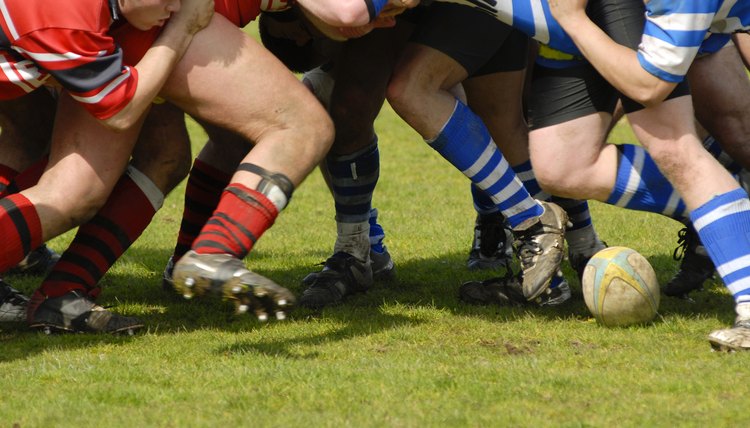What Is the Difference Between Rugby Cleats & Football Cleats?

If you play rugby or American football, you need a quality pair of cleats. These shoes provide necessary traction on different types of playing surfaces and field conditions. When shopping for cleats, it is important to remember that rugby and American football use different types of cleats, and that league rules often specify what is appropriate.
Identification
A primary difference between the cleats used in rugby and in American football is the number of studs on the bottom of each shoe. Rugby cleats have six to eight studs, while American football cleats typically have at least seven to 12 studs and vary widely in the number. Some football cleats have more than 12 studs, especially the molded cleats favored by many youth football leagues.
Considerations
The Football Cleats Guide website states that molded cleats have small rubber or plastic studs permanently affixed to the sole of the shoe. It also notes that molded cleats are good for most grass fields. Some football cleats are made with detachable studs. In contrast, all rugby cleats come with detachable studs. Traditional rugby cleats also have a high-cut design to provide extra support to the ankle.
Features
British Broadcasting Corp. Sports reports that rugby players prefer cleats with detachable screw-in studs that can be changed according to the playing field surface. For a muddy or soft surface, rugby players attach longer studs. For drier, harder surfaces, they use shorter studs. Some American football players wear cleats with detachable studs, but these shoes have more studs than rugby cleats.
Types
Among rugby cleats, the types with six studs have two in the front, under the ball of the foot, and four in the back. The eight-stud types have six in the front and two on the heel. The Rugby Rugby website states that the six-stud design helps players run faster. Football cleats, which have more studs, can include some at the toes. Regulation 12 from the International Rugby Board (IRB), the governing organization for world rugby, describes rules for players’ clothing, including cleats. This regulation prohibits studs or cleats at the toe of the shoe.
Size
The IRB regulation prohibits rugby cleats with studs longer than 21 mm. In addition, cleats must have no sharp edges. The National Collegiate Athletic Association (NCAA), which governs college football, prohibits cleats greater than 1/2-inch in length. Cleat lengths in the National Football League range from 3/8-inch for normal conditions to one inch for extreme conditions, such as a winter game on a snowy field. Allowable cleats for high school football vary by association, but in general high school football prefers molded cleats or detachable cleats of no more than 1/2-inch in length.
References
Resources
Writer Bio
Shane Hall is a writer and research analyst with more than 20 years of experience. His work has appeared in "Brookings Papers on Education Policy," "Population and Development" and various Texas newspapers. Hall has a Doctor of Philosophy in political economy and is a former college instructor of economics and political science.
